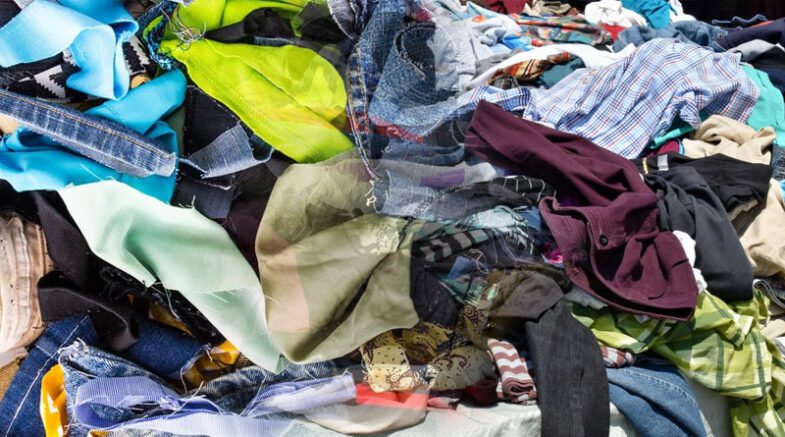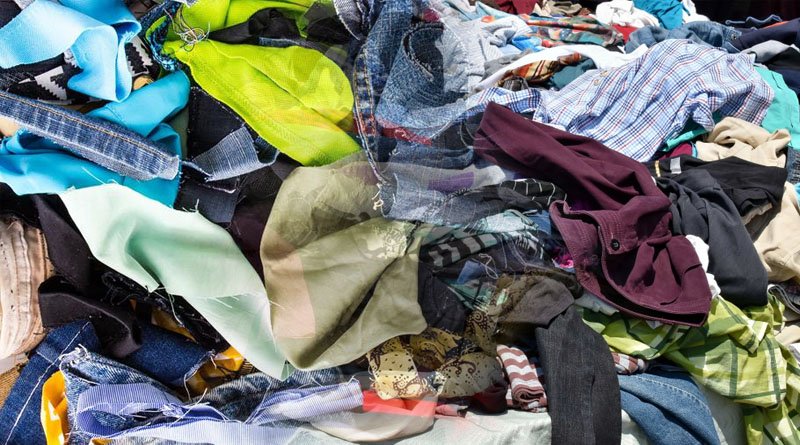A significant amount of textile waste streams are imported into Pakistan and add to the nation’s already severe ecosystem problems.

The export of textile waste or unwanted clothing to locations outside the EU has steadily increased in response to the rising global trends in fast fashion. In 2021, this export totaled 1.4 million tonnes. Every year, the EU collects about 2.1 million metric tonnes of post-consumer textiles and clothing for recycling or for sale on international resale markets.
This accounts for about 38% of the textiles sold in the EU. Any leftovers are disposed of in the mixed waste streams.
Pakistan is one of the destinations for post-consumer textile waste, or unwanted clothing discarded by the EU each year. Used clothing worth USD 46 million was exported from the EU to Pakistan in 2021. High-street clothing from the EU eventually makes its way to local dumping grounds and resale markets.
In the absence of effective waste hierarchy and traceability criteria that distinguish between textile waste and used textile products in both the EU and Pakistan, a significant amount of textile waste streams are imported into Pakistan and add to the nation’s already severe ecosystem problems.
Uncontrolled waste streams from used clothing and a lack of recycling not only increase greenhouse gas emissions and unsustainable water use because more new clothing is produced, but they also result in more textile waste being dumped in landfills.
The EU is currently giving sustainability top priority, encouraging textile circularity, and controlling the export of textile waste streams to other countries.
The game will change for the secondhand clothing and textile industry in Pakistan as a result of EU legislative reforms, which will not only significantly reduce the dumping of textile waste but will also support the alignment of the existing textile business models with the circular textile business models.
The main drivers of significant imports of used clothing from the EU to Pakistan are affordability and business through resale platforms. The consumer preference for used clothing, which is thought to be of higher quality, has increased as a result of the worsening economic crisis, which has made people more aware of their expenses. A significant portion of the used clothing imported into Pakistan is recycled, but the majority is sold directly.
When compared to the fashion industry and the production of new textiles, the country’s growing secondhand clothing market not only represents a pushback against the escalating fast-fashion systems. For instance, compared to the emissions and pollution from the production of new clothing, recycling and altering used clothing produces fewer GHGs and causes less water pollution.
A challenge to promoting textile circularity in Pakistan is the influx of unregulated textile waste streams, falsely labelled secondhand clothing, and unmonitored dumping of textile waste. Pakistan has a great deal of potential for redesigning and recycling used textiles.
According to the current situation, some industries recycle imported used clothing, but the progress is minimal, and the majority of these garments are dumped or sold in resale markets. Karachi Export Processing Zone (KEPZ) is greatly benefiting from the used textile industry, which recycles and resells imported used clothes globally.
Given the preference for the use of recycled material in new clothes, if industries are channeled into the market for recycled fashion, the recycling and redesigning of used clothes could become a significant business market for Pakistan.
Recycled polyester staple fibre (rPSF) is a highly suitable alternative for the industry to promote business through recycled fashion. The installation of recycling plants for the production of rPSF can uplift and green the industry’s business development, as it is the most preferred recycled content.
It supports sustainability and compliance with the Global Recycling Standards (GRS) due to various properties, including higher strength, low moisture absorbency, and high elasticity.
Textile circularity is now a matter of utmost attention for Pakistan’s textile industry. From knowledge dissemination to preparing skilled labour, implementing sustainable business models, and upscaling technology, textile companies are actively internalising the EU’s guidelines and strategies to achieve zero waste targets. Through coordination, the right financial allocations, and training, progress needs to be enhanced in the entire industry.
The industry will be obligated to adopt resource-efficient manufacturing processes and circular business models. This will not only promote the manufacturing of superior quality clothing but also the recycling of second-hand clothes.
The EU is introducing mandatory information standards on textile circularity and important environmental factors. This suggests that both in the EU and Pakistan, traceability mechanisms will gradually become applicable to used textile products. With the help of this mechanism, the lifecycle of the product can be tracked from the export of used textiles to the locations where they can be recycled and used again.
The EU’s Digital Product Passport is a milestone initiative to deal with “greenwashing,” which misleads buyers by giving a false impression of the environmental footprint of companies.
As the EU is a top textile export destination for Pakistan and is increasingly focusing on eco-design requirements for textiles, the management of post-consumer textile waste will fulfil the EU’s mounting requirements for textile circularity. This will require the right financial allocations, the upscaling of the current technology and skilled labour, and coordination among the relevant stakeholders.
